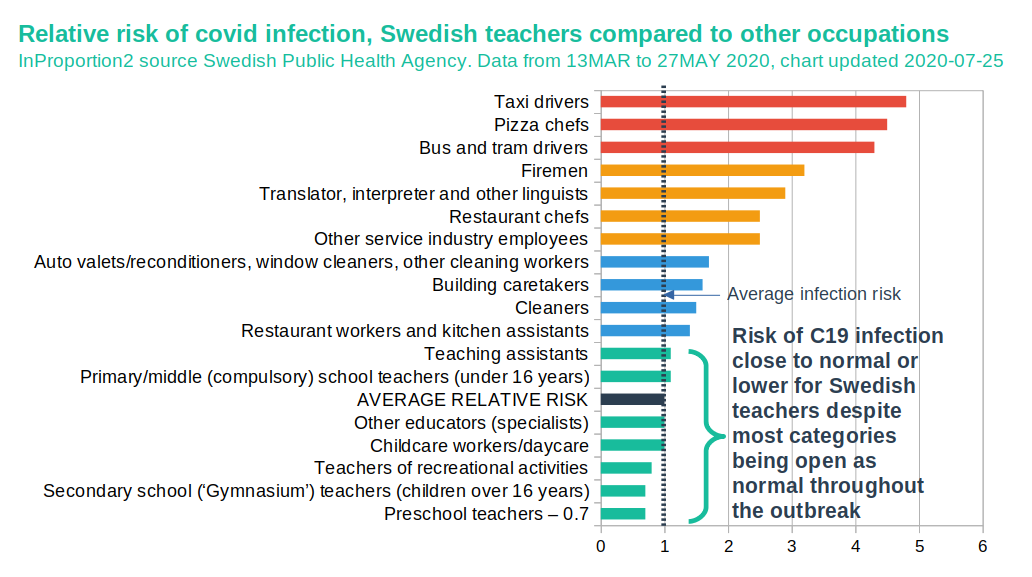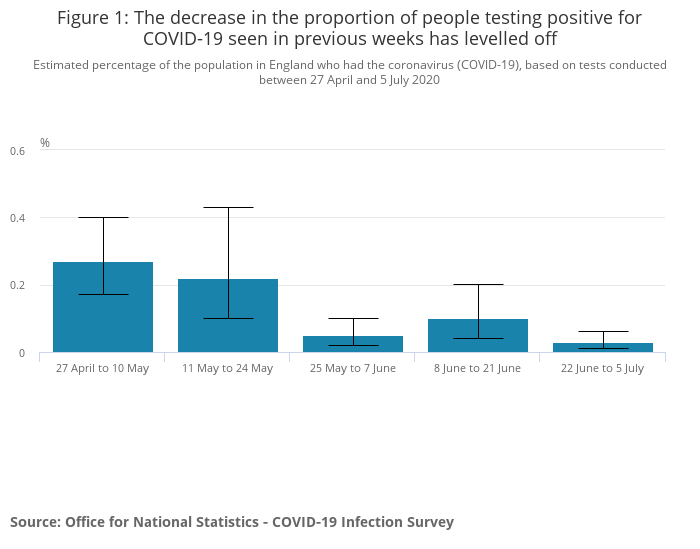
Data Source for the above chart
UK teachers have been spooked by the confusing messages of government and media.
Campaigns by teachers' unions to only open when it is 'safe' have further reinforced the sense that schools are risky for children and teachers.
Are teachers' fears justified?
Although UK schools have been open throughout the crisis for the children of key workers and for some vulnerable pupils, little if any analysis has been published in the UK to evaluate how safe the school environment has proved to be. Fortunately, we can turn to our Nordic neighbours Finland and Sweden for a thorough analysis.
Finland closed schools, Sweden did not. Covid infection levels for children were similar in both countries
The Public Health Agency of Sweden and the Finnish Institute for Health and Welfare published a study earlier this month into the incidence of laboratory-confirmed Covid-19 infections among school-aged children in the two countries.
Although Finland closed schools for most children and Sweden did not, and despite Sweden having been more affected by the outbreak overall, infection levels in children in both countries were very similar.
Both Sweden and Finland have had a very low number of Covid-19-positive children requiring ICU admissions, only 0.3% of the under-19 age group (2 individuals) in Finland, and 0.6% in Sweden (14 individuals). Contact tracing carried out in primary schools in Finland found no significant evidence of children infecting other persons. [1]
Teaching in Sweden has proved to be of average risk
In Sweden, it was found that compared to other occupations, the relative risk of Covid-19 incidence among teachers in day care, primary and secondary school was close to one, indicating no increased risk of exposure and infection in this group. This compares with a relative risk of 4.8 for taxi drivers and 4.5 for pizza chefs [2]
See chart above and here for the original presentation of the data together with our translation.
In both countries, the majority of children attend daycare from two years of age, and preschool the year they turn six. From seven to fifteen years of age they attend primary school, which is followed by three to four years of secondary school.
Combining the two countries, there are around 3.4 million individuals in the 0-19 age group, and in this group the report found no covid deaths at all.
Finnish-Swedish conclusions
The Finnish-Swedish study came to three main conclusions:
-
The closure of schools had no measurable effect on the number of cases of Covid-19 among children in Sweden and Finland.
-
Children are not a major risk group for Covid-19 and seem to play a less important role in transmission.
-
The negative effects of closing schools must be weighed against the positive effects, if any, this action might have on the mitigation of the Covid-19 pandemic.
This recent study builds upon a prior report at end-May from Sweden's Public Health Agency which concluded that the effects of school closures are 'mainly negative':
'The incidence of Covid-19 among children and young people is low. In most cases in which children have tested positive for Covid-19, they have been infected by an adult, and symptoms are mild. Additionally, children transmit infections less than adults do, and educational activities in Sweden have not been shown to drive the spread of infection. Furthermore, staff working within pre-school and educational settings have not had an increased level of Covid-19 incidence compared to other occupations. Studies show that school closures during the current pandemic have not made any significant impact on the control of transmission. On the other hand, school closures have other negative consequences for children and young people.' [3]
Swedish authorities and unions are both committed to keeping schools open as normal
Following the outbreak of Covid-19, Sweden never closed or limited daycare and compulsory schooling for children under 16, but on 17 March Swedish schools for over 16s changed to distance learning. According to Sweden's Education Minister Anna Ekström, the decision to keep schools open has enjoyed strong support from the country's teaching unions.[4] The Swedish government announced on 29 May that over-16s will be back in their classrooms when the new term starts in August. Sweden's health authority has never recommended its residents to wear face coverings in educational or other public settings, stating that, 'The scientific evidence around the effectiveness of face masks in combatting the spread of infection is weak.'[5]
Most European countries have either resumed normalised education or plan to do so. Why is the UK different?
-
Sweden never closed for under 16s and will reopen for all in August with only minimal changes to normal routines.
-
Denmark fully reopened on 15 April after being closed only one month.
-
Finland was closed to majority from 18 March until 13 May, but key worker children in grades 1-3 were in school the whole time.
-
France closed on 16 March and began gradual reopening on 11 May, reopening fully (except for high schools) on 22 June with compulsory attendance and normal hours. High schools continued distance learning and are set to open in September.
-
Netherlands closed 16 March and began to reopen from 11 May, with full reopen on 8 June.
What about masks - what is the official advice from Nordic health authorities?
Sweden:

Finland:


Norway:

Denmark:

See note [7] for sources
How much do we need to worry about infection transmission in schools, when the virus has almost disappeared?
According to the most recent Office for National Statistics report [8], the current levels of infection in the UK are extremely low, estimated to have fallen to 0.03%.

The discussion on whether to introduce masks into schools is more likely to generate unwarranted fear rather than achieve anything constructive, for a number of reasons:
-
infections have fallen to extremely low levels without masks
-
most who meet an infected person will not catch the infection
-
most who do get infected will have no symptoms, or will have only minor symptoms
Conclusions:
Teachers have an average risk of Covid infection even when schools are open and running as normal.
Across Europe, schools have been open as normal for weeks without negative consequences.
If Swedish teachers and pupils can attend school as normal, so can those in the UK.
Government and unions in the UK must avoid stoking fears teachers may have of school being unsafe, and get schools back to normal as soon as possible.
If the imposition of masks achieves anything in schools, it will be to stir up unwarranted fear about the risks posed by normally-functioning schools.
Sources:
-
[1] Covid-19 in schoolchildren – A comparison between Finland and Sweden,' Public Health Agency of Sweden and Finnish Institute for Health and Welfare, 7 July 2020. https://www.folkhalsomyndigheten.se/contentassets/c1b78bffbfde4a7899eb0d8ffdb57b09/covid-19-school-aged-children.pdf
-
[2] 'Förekomst av covid-19 i olika yrkesgrupper,' Public Health Agency of Sweden, 25 June 2020. https://www.folkhalsomyndigheten.se/contentassets/5e248b82cc284971a1c5fd922e7770f8/forekomst-covid-19-olika-yrkesgrupper.pdf
-
[3] 'Covid-19 hos barn och unga - en kunskapssammanställning,' Public Health Agency of Sweden, 29 May 2020 (Translation by InProportion2). https://www.folkhalsomyndigheten.se/contentassets/03fff9a4b6ba4b36b84f69a5f9486cbf/covid-19-barn-unga-kunskapssammanstallning.pdf
-
[4] As reported by BBC journalist Maddy Savage @maddysavage on Twitter following a news conference in Stockholm for foreign journalists, 11 June 2020.
-
[5] Covid-19 FAQs, Public Health Agency of Sweden, accessed 22 July 2020. www.folkhalsomyndigheten.se/the-public-health-agency-of-sweden/communicable-disease-control/covid-19/prevention/?exp=77795#_77795
-
[6] 'Instructions from the Finnish Institute for Health and Welfare and the Ministry of Education and Culture to providers of education and early childhood education and care during the COVID-19 epidemic,' 4 May 2020. https://valtioneuvosto.fi/documents/10616/22150002/THL+OKM+ohje+kouluihin+290420_EN.pdf
-
[7]
-
https://www.folkhalsomyndigheten.se/the-public-health-agency-of-sweden/communicable-disease-control/covid-19/prevention/?exp=68218#_68218
-
https://valtioneuvosto.fi/documents/10616/22150002/THL+OKM+ohje+kouluihin+290420_EN.pdf
-
https://www.sst.dk/en/english/corona-eng/faq
-
https://www.fhi.no/globalassets/dokumenterfiler/rapporter/2020/should-individuals-in-the-community-without-respiratory-symptoms-wear-facemasks-to-reduce-the-spread-of-covid-19-report-2020.pdf
-
-
[8] https://www.ons.gov.uk/peoplepopulationandcommunity/healthandsocialcare/conditionsanddiseases/bulletins/coronaviruscovid19infectionsurveypilot/england9july2020